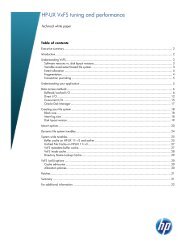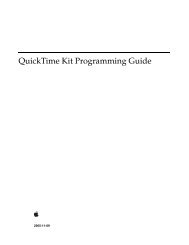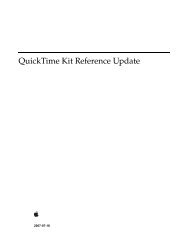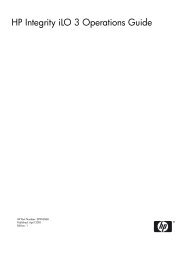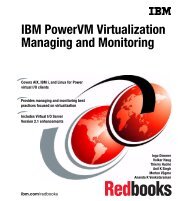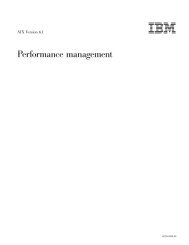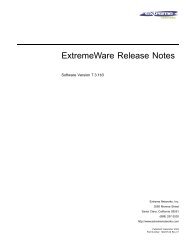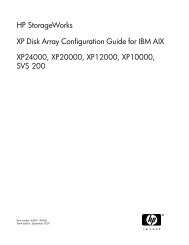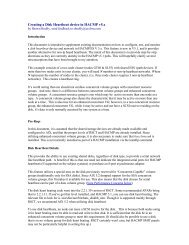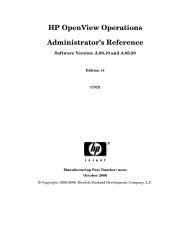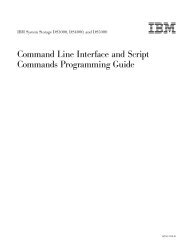VERITAS File System™ 3.5 - filibeto.org
VERITAS File System™ 3.5 - filibeto.org
VERITAS File System™ 3.5 - filibeto.org
Create successful ePaper yourself
Turn your PDF publications into a flip-book with our unique Google optimized e-Paper software.
<strong>VERITAS</strong> <strong>File</strong> System <strong>3.5</strong><br />
Release Notes<br />
Solaris<br />
August 2002<br />
30-000585-011
Disclaimer<br />
The information contained in this publication is subject to change without notice.<br />
<strong>VERITAS</strong> Software Corporation makes no warranty of any kind with regard to this<br />
manual, including, but not limited to, the implied warranties of merchantability and<br />
fitness for a particular purpose. <strong>VERITAS</strong> Software Corporation shall not be liable for<br />
errors contained herein or for incidental or consequential damages in connection with the<br />
furnishing, performance, or use of this manual.<br />
Copyright<br />
Copyright © 2002 <strong>VERITAS</strong> Software Corporation. All rights reserved. <strong>VERITAS</strong>,<br />
<strong>VERITAS</strong> Software, the <strong>VERITAS</strong> logo, <strong>VERITAS</strong> <strong>File</strong> System, and all other <strong>VERITAS</strong><br />
product names and slogans are trademarks or registered trademarks of <strong>VERITAS</strong><br />
Software Corporation in the USA and/or other countries. Other product names<br />
mentioned herein may be trademarks or registered trademarks of their respective<br />
companies.<br />
August 2002.<br />
<strong>VERITAS</strong> Software Corporation<br />
350 Ellis Street<br />
Mountain View, CA 94043<br />
USA<br />
Phone 650–527–8000<br />
Fax 650–527–2908<br />
http://www.veritas.com
<strong>VERITAS</strong> <strong>File</strong> System Release Notes<br />
This guide provides information on <strong>VERITAS</strong> <strong>File</strong> System (VxFS) release <strong>3.5</strong>. The <strong>3.5</strong><br />
release of VxFS operates on the following Solaris operating systems:<br />
◆ Solaris 2.6<br />
◆ Solaris 7 (32-bit and 64-bit)<br />
◆ Solaris 8 (32-bit and 64-bit)<br />
◆ Solaris 9 (32-bit and 64-bit)<br />
<strong>VERITAS</strong> Cluster <strong>File</strong> System (CFS), the clustering functionality of VxFS, is supported<br />
only on Solaris 8 and Solaris 9 (see “Using Cluster <strong>File</strong> Systems” on page 4 for more<br />
information). The <strong>VERITAS</strong> <strong>File</strong> System package includes VxFS software, documentation,<br />
and the optionally licensed <strong>VERITAS</strong> Quick I/O for Databases and <strong>VERITAS</strong> QuickLog features.<br />
Review this entire document before installing VxFS. Topics include:<br />
◆ New Features<br />
◆ End of Product Support<br />
◆ Using <strong>VERITAS</strong> Quick I/O and <strong>VERITAS</strong> QuickLog<br />
◆ Using Cluster <strong>File</strong> Systems<br />
◆ Compatibility With Previous Versions of VxFS<br />
◆ VxFS Packages<br />
◆ Required Solaris Patches<br />
◆ Documentation<br />
◆ Command Summary<br />
◆ Software Issues in VxFS<br />
◆ Using VxFS in VCS and Other HA Environments<br />
◆ Getting Help<br />
◆ Licensing and Support From Sun Microsystems<br />
1
New Features<br />
New Features<br />
VxFS Release <strong>3.5</strong> has the following new features and changes.<br />
▼ Solaris 9 Support<br />
<strong>VERITAS</strong> <strong>File</strong> System now operates on Solaris 9 in 32-bit and 64-bit mode.<br />
▼ 32-Terabyte <strong>File</strong> System Support<br />
The <strong>3.5</strong> release is the first major VxFS release to support a new disk layout (version 5) that<br />
enables the creation of file system up to 32 terabytes in size. <strong>File</strong> systems created on<br />
VxFS <strong>3.5</strong> will by default use the new disk layout, but files created on Version 5 can still<br />
only be a maximum of two terabytes. <strong>File</strong> systems larger than 1TB can be created only on<br />
64-bit kernels and must be created on a <strong>VERITAS</strong> Volume Manager volume. An eight<br />
terabyte file system requires a 2K block size, a 16 TB file system requires a 4K block size,<br />
and a 32 TB file system requires an 8K block size. An online conversion utility,<br />
vxupgrade, is provided to upgrade existing disk layouts to Version 5 on mounted file<br />
systems.<br />
▼ New <strong>VERITAS</strong> Product Distribution Method<br />
The <strong>VERITAS</strong> software disc has an automated installation and licensing procedure that<br />
lets you install packages using an Installation Menu instead of installing from the<br />
command line. This automated installation process is valid only for new product<br />
installations and cannot be used to upgrade from previous product versions.<br />
<strong>VERITAS</strong> has also introduced a website from which you can quickly and easily obtain a<br />
license key for the products that you have purchased. The Product License and Installation<br />
Guide, included with the <strong>VERITAS</strong> software disc, provides complete information. Review<br />
the Product License and Installation Guide before installing VxFS.<br />
▼ <strong>VERITAS</strong> Enterprise Administrator<br />
The <strong>VERITAS</strong> Enterprise Administrator (VEA) is the new global graphical user interface<br />
used by <strong>VERITAS</strong> products. Some major VxFS functions, such as mounting,<br />
defragmenting, and creating snapshot file systems can be performed through the VEA<br />
GUI. VEA is installed with the <strong>VERITAS</strong> Volume Manager. See the <strong>VERITAS</strong> Volume<br />
Manager User’s Guide – <strong>VERITAS</strong> Enterprise Administrator for details on configuring the<br />
GUI and using VxFS functionality.<br />
▼ Group Quotas<br />
The VxFS quota-related commands now support group quotas along with individual user<br />
disk quotas. The quota commands have a –g option to distinguish group operations, and<br />
a group quotas file, quotas.grp, is required to maintain group quota information.<br />
2 <strong>VERITAS</strong> <strong>File</strong> System Release Notes
▼ New and Enhanced Tunable Parameters<br />
The following tunables were added or updated for <strong>3.5</strong>:<br />
<strong>VERITAS</strong> <strong>File</strong> System Release Notes 3<br />
New Features<br />
hsm_write_prealloc Preallocates uninitialized space in a managed region of a file<br />
to improve performance when using HSM applications with<br />
VxFS.<br />
read_ahead Detects complex read-ahead patterns in addition to<br />
sequential reads.<br />
write_throttle Alters the number of dirty pages generated before flushing<br />
to disk to take advantage of new disk storage technology.<br />
See the vxtunefs(1M) manual page for more information. A kernel tunable,<br />
vx_maxlink, determines the number of sub-directories that can be created under a<br />
directory. vx_maxlink is set in the system configuration file. See the <strong>VERITAS</strong> <strong>File</strong> System<br />
Administrator’s Guide for more information.<br />
▼ Maximum QuickLog Log Size Increased<br />
To improve performance, the QuickLog device log size maximum was increased from two<br />
gigabytes to 500 gigabytes.<br />
▼ VxFS Command Enhancements<br />
The vxdump command now enables backups at the file or directory level.<br />
The vxrestore command now bypasses the system buffer cache when restoring data.<br />
This allows a system’s buffer cache to remain intact while doing an extensive restore<br />
operation which typically improves system performance. The vxrestore –c option<br />
preserves backwards compatibility by allowing vxrestore to use the buffer cache.<br />
The vxupgrade command can now upgrade an existing VxFS file system to the Version 5<br />
layout while the file system remains online.<br />
The vxfsconvert command can now convert unmounted file systems with Version 1<br />
and Version 2 disk layouts to Version 5. VxFS Version 4 disk layouts cannot be converted<br />
to Version 5 offline.<br />
The logiosize=size option was added to the mount command to enhance the<br />
performance of storage devices that employ a read-modify-write feature. To obtain the<br />
maximum performance from such devices, intent log writes can be done in 512, 1024,<br />
2048, 4096, or 8192 bytes.
End of Product Support<br />
End of Product Support<br />
This release is the last to support the VxFS Version 1 and Version 2 disk layouts. You can<br />
still mount these older disk layout versions, but you cannot create them using the<br />
<strong>VERITAS</strong> mkfs command. <strong>VERITAS</strong> recommends that you upgrade file systems using<br />
these older disk layouts to Version 5. See “Compatibility With Previous Versions of VxFS”<br />
below for information on upgrading.<br />
This is the last release to support the QuickLog statistic gathering functionality provided<br />
by the qlogstat command. Also, future releases of QuickLog will support only one<br />
VxFS file system per QuickLog device instead of the current 32 file systems per QuickLog<br />
device.<br />
Sun Microsystems has announced the End of Support Life for Solaris 2.6. Contact Sun<br />
customer support for more information.<br />
Using <strong>VERITAS</strong> Quick I/O and <strong>VERITAS</strong> QuickLog<br />
The <strong>VERITAS</strong> <strong>File</strong> System package, VRTSvxfs, includes two separately licensed<br />
products, <strong>VERITAS</strong> Quick I/O for Databases and <strong>VERITAS</strong> QuickLog. These features are<br />
described in the <strong>VERITAS</strong> <strong>File</strong> System Administrator's Guide. A QuickLog license is<br />
included with <strong>VERITAS</strong> Editions products and <strong>VERITAS</strong> Foundation Suite. Quick I/O is<br />
available only with <strong>VERITAS</strong> Editions products.<br />
See “Getting Help” on page 20 for contact information on these products.<br />
Using Cluster <strong>File</strong> Systems<br />
Cluster <strong>File</strong> System (CFS) is the file system clustering functionality of VxFS. CFS is a<br />
separately licensable feature of VxFS that requires several other <strong>VERITAS</strong> products to<br />
enable communication services and provide shared disk storage resources. The <strong>VERITAS</strong><br />
Cluster Server (VCS) and <strong>VERITAS</strong> Volume Manager (VxVM) are packaged with VxFS<br />
in the SANPoint Foundations Suite (SPFS) to provide a complete clustering environment.<br />
There is also high availability version, SPFS HA.<br />
See “Getting Help” on page 20 for contact information on these products.<br />
4 <strong>VERITAS</strong> <strong>File</strong> System Release Notes
Compatibility With Previous Versions of VxFS<br />
Compatibility With Previous Versions of VxFS<br />
Note <strong>VERITAS</strong> recommends upgrading any previously installed VxFS file system to<br />
VxFS <strong>3.5</strong> with Version 5 disk layout.<br />
VxFS <strong>3.5</strong> file systems employ disk layout Version 5. With the <strong>3.5</strong> release, you can no longer<br />
create Version 1 or Version 2 disk layout file systems, but the older disk layout file systems<br />
can still be mounted. You should begin upgrading any Version 1 or Version 2 disk layout<br />
file systems to Version 5 for them to be usable on future releases of VxFS. Cluster file<br />
systems and Storage Checkpoints require the Version 4 or higher disk layout to operate.<br />
You can do the upgrade online using the vxupgrade command (see the vxupgrade(1M)<br />
manual page for details). You can use vxfsconvert (see vxfsconvert(1M)) on<br />
unmounted file systems. The following are issues to consider when planning disk layout<br />
upgrades:<br />
◆ Version 1 disk layout file systems can support more than 8 million inodes, while<br />
Version 2 disk layout file systems have an 8 million inode limit.<br />
◆ The Version 1 disk layout provides finer control of disk geometry than subsequent<br />
disk layouts. This finer control is not relevant on disks employing newer technologies,<br />
but can still be applicable on older hardware. If you are using Version 1 disk layout<br />
file systems on older hardware that needs fine control of disk geometry, a disk layout<br />
upgrade may be problematic.<br />
◆ Images of Version 1 or Version 2 disk layout file systems created by copy utilities, such<br />
as dd or volcopy, will become unusable after a disk layout upgrade. Offline<br />
conversions tools will be provided in the next VxFS feature release to aid in migrating<br />
volume-image backup copies of Version 1 and Version 2 disk layout file systems to a<br />
Version 5 disk layout.<br />
<strong>VERITAS</strong> <strong>File</strong> System Release Notes 5
VxFS Packages<br />
VxFS Packages<br />
There are multiple software discs in the <strong>VERITAS</strong> product distribution. VxFS is on<br />
<strong>VERITAS</strong> Storage Solutions <strong>3.5</strong> for Solaris Disc 1.The following file system packages in the<br />
file_system/pkgs directory of Disc 1:<br />
◆ VRTSvxfs—VxFS software and online manual pages<br />
◆ VRTSfsdoc—VxFS Documentation<br />
◆ VRTSvlic—<strong>VERITAS</strong> products licensing facility<br />
◆ VRTSfspro—<strong>VERITAS</strong> <strong>File</strong> System Management Services Provider<br />
◆ VRTSob—<strong>VERITAS</strong> Enterprise Administrator Service<br />
◆ VRTSobgui—<strong>VERITAS</strong> Enterprise Administrator<br />
VRTSvxfs is the required VxFS binary package and VRTSfsdoc is the optional VxFS<br />
documentation package.<br />
VRTSvlic is the required licensing package for all <strong>VERITAS</strong> products. VRTSvlic may<br />
already be available on your system if you have installed another <strong>VERITAS</strong> <strong>3.5</strong> product.<br />
VRTSfspro, VRTSob, and VRTSobgui are part of the <strong>VERITAS</strong> Enterprise Administrator<br />
(VEA) GUI. These packages are typically installed by the <strong>VERITAS</strong> Volume Manger or<br />
<strong>VERITAS</strong> Foundation Suite and are not required for VxFS to operate.<br />
See the <strong>VERITAS</strong> <strong>File</strong> System Installation Guide for complete instructions on how to<br />
install the VxFS packages.<br />
Note VxFS is a licensed product; you must obtain a license key before installing it.<br />
License keys valid for VxFS 2.3.x and other 3.x <strong>File</strong> Systems are also valid for<br />
<strong>VERITAS</strong> <strong>3.5</strong> <strong>File</strong> Systems. For information on obtaining a license key, see the<br />
<strong>VERITAS</strong> <strong>File</strong> System Installation Guide.<br />
6 <strong>VERITAS</strong> <strong>File</strong> System Release Notes
Required Solaris Patches<br />
Required Solaris Patches<br />
For <strong>VERITAS</strong> <strong>File</strong> System functionality to work reliably on Solaris 8, you must have the<br />
following Solaris patches, or their later versions, installed:<br />
108528-14 (requires patches 108987-09, 111293-04, 111310-01, 111111-03, and 112396-02)<br />
108901-04<br />
Add the patches in the following order or they will not install correctly:<br />
112396-01<br />
108987-09<br />
111293-01<br />
111310-01<br />
111111-03<br />
108528-14<br />
108901-04<br />
Documentation<br />
The following documents accompany this VxFS release as Adobe Portable Document<br />
Format (PDF) files:<br />
◆ <strong>VERITAS</strong> <strong>File</strong> System Installation Guide<br />
◆ <strong>VERITAS</strong> <strong>File</strong> System Administrator’s Guide<br />
The VRTSvxfs package contains manual pages for VxFS commands and utilities.<br />
The <strong>VERITAS</strong> <strong>File</strong> System Release Notes are provided on the <strong>VERITAS</strong> software disc in the<br />
file vxfs_notes.pdf under the file_system/release_notes directory. Because<br />
product release notes are not installed by any packages, <strong>VERITAS</strong> recommends that you<br />
copy them from the <strong>VERITAS</strong> software disc to the /opt/VRTSfsdoc directory so that<br />
they are available on your system for future reference.<br />
<strong>VERITAS</strong> <strong>File</strong> System Release Notes 7
Documentation<br />
Displaying Documentation Online<br />
The <strong>VERITAS</strong> <strong>File</strong> System guides are provided on the <strong>VERITAS</strong> software disc under the<br />
file_system/docs directory as PDF files. To view or print PDF documents, you need<br />
the Adobe Acrobat Reader. The following two documents comprise the VxFS<br />
documentation set:<br />
◆ <strong>VERITAS</strong> <strong>File</strong> System Installation Guide<br />
After installing the VRTSfsdoc package, you can access this guide in the following<br />
location: /opt/VRTSfsdoc/vxfs_ig.pdf.<br />
◆ <strong>VERITAS</strong> <strong>File</strong> System Administrator’s Guide<br />
After installing the VRTSfsdoc package, you can access this guide in the following<br />
location /opt/VRTSfsdoc/vxfs_ag.pdf.<br />
See the <strong>VERITAS</strong> <strong>File</strong> System Installation Guide for VRTSfsdoc package installation<br />
information. The VRTSvxfs package contains manual pages for VxFS administration<br />
commands.<br />
Cluster <strong>File</strong> System Documentation<br />
There is a separate documentation package named VRTScfsdc for the Cluster <strong>File</strong><br />
System. The VRTScfsdc documentation package contains the same <strong>VERITAS</strong> <strong>File</strong> System<br />
Administrator’s Guide as VRTSfsdoc, but has a different installation guide named the<br />
<strong>VERITAS</strong> SANPoint Foundation Suite Installation and Configuration Guide that includes<br />
cluster administration information.<br />
The online manual pages available with the <strong>VERITAS</strong> <strong>File</strong> System (listed under “Online<br />
Manual Pages” on page 9) are also available with the Cluster <strong>File</strong> System. There is a<br />
section in each VxFS manual page detailing any cluster functionality issues associated<br />
with that command (see “Using Cluster <strong>File</strong> Systems” on page 4).<br />
8 <strong>VERITAS</strong> <strong>File</strong> System Release Notes
Online Manual Pages<br />
<strong>VERITAS</strong> <strong>File</strong> System Release Notes 9<br />
Documentation<br />
This release includes the following online manual pages as part of the VRTSvxfs<br />
package. These are installed in the appropriate directories under /opt/VRTS/man (add<br />
this to your MANPATH environment variable), but does not update the windex database.<br />
To ensure that new VxFS manual pages display correctly, update the windex database<br />
after installing VRTSvxfs. See the catman(1M) manual page for more information.<br />
Section 1 Description<br />
cp_vxfs VxFS-specific copy command.<br />
cpio_vxfs VxFS-specific cpio command.<br />
getext Gets extent attributes for a VxFS file system.<br />
ls_vxfs VxFS-specific list command.<br />
mv_vxfs VxFS-specific move command.<br />
qioadmin 1 VxFS Quick I/O for Databases cache administration utility.<br />
qiomkfile 1 Creates a VxFS Quick I/O device file.<br />
qiostat 1 VxFS Quick I/O for Databases statistics utility.<br />
setext Sets extent attributes on a file in a VxFS file system.<br />
Section 1M Description<br />
cfscluster 3,4 CFS cluster configuration command.<br />
cfsdgadm 3,4 Adds or deletes shared disk groups to/from a cluster configuration.<br />
cfsmntadm 3,4 Adds, deletes, modifies, and sets policy on cluster mounted file systems.<br />
cfsmount,<br />
cfsumount 3,4<br />
Mounts or unmounts a cluster file system.<br />
df_vxfs Reports the number of free disk blocks and inodes for a VxFS file system.<br />
ff_vxfs Lists file names and inode information for a VxFS file system.<br />
fsadm_vxfs Resizes or re<strong>org</strong>anizes a VxFS file system.<br />
fscat_vxfs Cats a VxFS file system.<br />
fsck_vxfs Checks and repairs a VxFS file system.<br />
fsckptadm 5 VxFS Storage Checkpoint administration utility.<br />
fsclustadm 3, 5 Manages cluster-mounted VxFS file systems.<br />
fsdb_vxfs VxFS file system debugger.<br />
fstyp_vxfs Returns the type of file system on a specified disk partition.<br />
glmconfig 3 Group Lock Manager (GLM) configuration utility.
Documentation<br />
mkfs_vxfs Constructs a VxFS file system.<br />
mount_vxfs Mounts a VxFS file system.<br />
ncheck_vxfs Generates path names from inode numbers for a VxFS file system.<br />
qlogadm 2 Low level ioctl utility for the QuickLog driver.<br />
qlogattach 2 Attaches a previously formatted QuickLog volume to a QuickLog device.<br />
qlogck 2 Recovers QuickLog devices during the boot process.<br />
qlogclustadm 2,4 Cluster QuickLog device administrative utility.<br />
qlogdb 2 QuickLog debugging tool.<br />
qlogdetach 2 Detaches a QuickLog volume from a QuickLog device.<br />
qlogdisable 2 Remounts a VxFS file system with QuickLog logging disabled.<br />
qlogenable 2 Remounts a VxFS file system with QuickLog logging enabled.<br />
qlogmk 2 Creates and attaches a QuickLog volume to a QuickLog device.<br />
qlogprint 2 Displays records from the QuickLog configuration.<br />
qlogrec 2 Recovers the QuickLog configuration file during a system failover.<br />
qlogrm 2 Removes a QuickLog volume from the configuration file.<br />
qlogstat 2 Prints statistics for running QuickLog devices, QuickLog volumes, and VxFS file<br />
systems.<br />
qlogtrace 2 Prints QuickLog tracing.<br />
umount_vxfs Unmounts a VxFS file system.<br />
vxdump Incremental file system dump.<br />
vxedquota Edits user quotas for a VxFS file system.<br />
vxfsconvert Converts an unmounted file system to VxFS or upgrades a VxFS disk layout<br />
version.<br />
vxfsstat Displays file system statistics.<br />
vxquot Displays file system ownership summaries for a VxFS file system.<br />
vxquota Displays user disk quotas and usage on a VxFS file system.<br />
vxquotaoff<br />
vxquotaon<br />
Turns quotas on and off for a VxFS file system.<br />
vxrepquota Summarizes quotas for a VxFS file system.<br />
vxrestore Restores a file system incrementally.<br />
vxtunefs Tunes a VxFS file system.<br />
vxupgrade Upgrades the disk layout of a mounted VxFS file system.<br />
10 <strong>VERITAS</strong> <strong>File</strong> System Release Notes
Section 4 Description<br />
fs_vxfs Format of a VxFS file system volume.<br />
inode_vxfs Format of a VxFS file system inode.<br />
qlog_config 2 QuickLog configuration file.<br />
tunefstab VxFS file system tuning parameters table.<br />
Section 7 Description<br />
qlog 2 <strong>VERITAS</strong> QuickLog device driver.<br />
vxfsio VxFS file system control functions.<br />
1 Functionality available only with <strong>VERITAS</strong> Quick I/O for Databases feature<br />
2 Functionality available only with <strong>VERITAS</strong> QuickLog feature<br />
3 Functionality available only with the <strong>VERITAS</strong> Cluster <strong>File</strong> System product<br />
4 New in VxFS <strong>3.5</strong><br />
<strong>VERITAS</strong> <strong>File</strong> System Release Notes 11<br />
Documentation
Command Summary<br />
Command Summary<br />
Symbolic links to all VxFS command executables are installed in the /opt/VRTS/bin<br />
directory. Add this directory to the end of your PATH environment variable to access the<br />
commands:<br />
Command Description<br />
cp VxFS-specific copy command.<br />
cpio VxFS-specific cpio command.<br />
cfscluster 3,4 CFS cluster configuration command.<br />
cfsdgadm 3,4 Adds or deletes shared disk groups to/from a cluster configuration.<br />
cfsmntadm 3,4 Adds, deletes, modifies, and sets policy on cluster mounted file systems.<br />
cfsmount,<br />
cfsumount 3,4<br />
Mounts or unmounts a cluster file system.<br />
df Reports the number of free disk blocks and inodes for a VxFS file system.<br />
ff Lists file names and inode information for a VxFS file system.<br />
fsadm Resizes or defragments a VxFS file system.<br />
fscat Cats a VxFS file system.<br />
fsck Checks and repairs a VxFS file system.<br />
fsckptadm 5 VxFS Storage Checkpoint administration utility.<br />
fsclustadm 3, 5 Manages cluster-mounted VxFS file systems.<br />
fsdb VxFS file system debugger.<br />
fstyp Returns the type of file system on a specified disk partition.<br />
getext Gets extent attributes for a VxFS file system.<br />
glmconfig 3 Group Lock Manager (GLM) configuration utility.<br />
ls VxFS-specific list command.<br />
mkfs Constructs a VxFS file system.<br />
mount Mounts a VxFS file system.<br />
mv VxFS-specific move command.<br />
ncheck Generates path names from inode numbers for a VxFS file system.<br />
qioadmin 1 VxFS Quick I/O for Databases cache administration utility.<br />
qiomkfile 1 Creates a VxFS Quick I/O device file.<br />
qiostat 1 VxFS Quick I/O for Databases statistics utility.<br />
12 <strong>VERITAS</strong> <strong>File</strong> System Release Notes
Command Description<br />
qlogadm 2 Low level IOCTL utility for the QuickLog driver.<br />
Command Summary<br />
qlogattach 2 Attaches a previously formatted QuickLog volume to a QuickLog device.<br />
qlogck 2 Recovers QuickLog devices during the boot process.<br />
qlogclustadm 2,4 Cluster QuickLog device administrative utility.<br />
qlogdb 2 QuickLog debugging tool.<br />
qlogdetach 2 Detaches a QuickLog volume from a QuickLog device.<br />
qlogdisable 2 Remounts a VxFS file system with QuickLog logging disabled.<br />
qlogenable 2 Remounts a VxFS file system with QuickLog logging enabled.<br />
qlogmk 2 Creates and attaches a QuickLog volume to a QuickLog device.<br />
qlogprint 2 Displays records from the QuickLog configuration.<br />
qlogrec 2 Recovers the QuickLog configuration file during a system failover.<br />
qlogrm 2 Removes a QuickLog volume from the configuration file.<br />
qlogstat 2 Prints statistics for running QuickLog devices, QuickLog volumes, and VxFS file<br />
systems.<br />
qlogtrace 2 Prints QuickLog tracing.<br />
<strong>VERITAS</strong> <strong>File</strong> System Release Notes 13
Command Summary<br />
Command Description<br />
setext Sets extent attributes on a file in a VxFS file system.<br />
umount_vxfs 5 Unmounts a VxFS file system.<br />
vxdump Incremental file system dump.<br />
vxedquota Edits user quotas for a VxFS file system.<br />
vxfsconvert Converts an unmounted file system to VxFS or upgrades a VxFS disk layout<br />
version.<br />
vxfsstat Displays file system statistics.<br />
vxquot Displays file system ownership summaries for a VxFS file system.<br />
vxquota Displays user disk quotas and usage on a VxFS file system.<br />
vxquotaoff<br />
vxquotaon<br />
Turns quotas on and off for a VxFS file system.<br />
vxrepquota Summarizes quotas for a VxFS file system.<br />
vxrestore Restores a file system incrementally.<br />
vxtunefs Tunes a VxFS file system.<br />
vxupgrade Upgrades the disk layout of a mounted VxFS file system.<br />
1 Functionality available only with <strong>VERITAS</strong> Quick I/O for Databases feature<br />
2 Functionality available only with <strong>VERITAS</strong> QuickLog feature<br />
3 Functionality available only with the <strong>VERITAS</strong> Cluster <strong>File</strong> System product<br />
4 New in VxFS <strong>3.5</strong><br />
14 <strong>VERITAS</strong> <strong>File</strong> System Release Notes
Software Issues in VxFS<br />
Software Issues in VxFS<br />
▼ Stack Size Change<br />
When installed on Solaris 7, Solaris 8, and Solaris 9 VxFS changes the default stack to 24K<br />
for 64–bit systems. If you are using systems only in 32–bit mode, you can change the stack<br />
size back to 16K. The stack size is 16K for Solaris 2.6. The stack size is designated in the<br />
Solaris configuration file /etc/system.<br />
▼ Storage Checkpoints Do Not Operate with HSM Products<br />
Storage Checkpoints cannot be created on a file system where the <strong>VERITAS</strong> Storage<br />
Migrator is active, or with other hierarchical storage management (HSM) products that<br />
use the DMAPI interface.<br />
▼ VxFS <strong>3.5</strong> Incompatible with HSM Applications<br />
VxFS <strong>3.5</strong> does not operate with <strong>VERITAS</strong> Storage Migrator versions 4.5 and earlier. A<br />
patch for <strong>VERITAS</strong> Storage Migrator 4.5 is available from <strong>VERITAS</strong> support on the<br />
<strong>VERITAS</strong> Customer Support website:<br />
http://seer.support.veritas.com/docs/249443.htm<br />
Other HSM applications may also require a patch. Contact your HSM vendor for<br />
product-specific information.<br />
▼ Disable QuickLog Device Logging Before Installing VxFS <strong>3.5</strong><br />
Because of the QuickLog disk layout change in VxFS <strong>3.5</strong>, you must disable QuickLog<br />
logging on any file systems mounted with the mount qlog option before upgrading. See<br />
the <strong>VERITAS</strong> <strong>File</strong> System Installation Guide for more information.<br />
▼ The ustat Command Returns Error for VxFS <strong>File</strong> Systems Larger than One Terabyte<br />
The ustat command returns an EOVERFLOW error for VxFS files systems larger than<br />
one terabyte because the variable used to store file system size overflows (see the<br />
ustat(2) manual page).<br />
▼ Commands Must be Large <strong>File</strong> Aware to Operate Correctly on <strong>File</strong> Systems Larger<br />
than One Terabyte<br />
For utilities to operate correctly on large file systems, they must be large file aware. This<br />
applies even if commands are invoked on small files in a large file system. See the Disk<br />
Layout chapter in the <strong>VERITAS</strong> <strong>File</strong> System Administrator’s Guide for more information.<br />
<strong>VERITAS</strong> <strong>File</strong> System Release Notes 15
Software Issues in VxFS<br />
▼ Inode Limitation on <strong>File</strong> Systems Without Large <strong>File</strong> Support<br />
For a file system to have more than 8 million inodes, you must create it using the<br />
largefiles option of mkfs (the fsadm utility can also be used to set the largefiles<br />
flag on the file system). See the mkfs_vxfs(1M) and fsadm_vxfs(1M) manual pages for<br />
details.<br />
▼ vxupgrade Does Not Upgrade Older Disk Layouts Directly to Version 5<br />
The vxupgrade command upgrades older disk layouts in stages, so a Version 1 file<br />
system disk layout must be upgraded to Version 2, Version 2 to Version 4, then Version 4<br />
to Version 5. The vxfsconvert command upgrades unmounted Version 1 and Version 2<br />
disk layouts directly to Version 4, but vxupgrade must be used to convert to Version 5.<br />
▼ Quick I/O <strong>File</strong>s Cannot Be Sparse <strong>File</strong>s<br />
If you try to convert a sparse file to a Quick I/O file, the Oracle instance can fail if Oracle<br />
tries to write into an unallocated block. Specifically, datafiles used by the Oracle8i and<br />
Oracle9i temporary tablespace may be sparse files, so do not convert these to Quick I/O<br />
files. See the <strong>VERITAS</strong> Database Edition for Oracle Database Administrator’s Guide for more<br />
information.<br />
▼ Increased Kernel Stack Size Required<br />
VxFS often requires more than the default 8K kernel stack size, so during the VRTSvxfs<br />
installation, entries are added to /etc/system to increase the kernel thread stack size to<br />
16K.<br />
▼ Panics on Solaris 8 Operating Systems<br />
There are possible stack overflow problems on VxFS file systems that are NFS exported.<br />
The problem occurs only on Solaris 8, 32-bit systems. If you are using Solaris 8 Update 2 or<br />
earlier, follow these steps to increase the NFS thread stack size:<br />
1. Apply Sun Microsystems patch number 108901-03 or later. See the patchadd(1M)<br />
manual page for information on installing patches.<br />
2. Add the following line to the file /etc/system:<br />
set rpcmod:svc_default_stksize=0x4000<br />
3. Reboot the system.<br />
Caution For Solaris 8 Update 2 or earlier, you must apply this patch on both 32-bit and<br />
64-bit operating systems before altering the default stack size parameter,<br />
otherwise the system will panic on reboot.<br />
16 <strong>VERITAS</strong> <strong>File</strong> System Release Notes
Software Issues in VxFS<br />
If you are using Solaris 8 Update 3, follow these steps to increase the stack size:<br />
1. Add the following line to the file /etc/system:<br />
set rpcmod:svc_default_stksize=0x4000<br />
2. Reboot the system.<br />
▼ Some Disk Quota Operations Do Not Function on NFS<br />
When VxFS file systems are exported via NFS, quotas on the file system apply to users<br />
when accessing the file system from NFS clients. However, neither the Solaris nor the<br />
VxFS quota commands on the NFS client can be used to query or edit quotas.<br />
The VxFS quota commands can be used on the server to query or edit quotas.<br />
▼ Non-standard Command Behavior When Using Access Control Lists (ACLs)<br />
The output of the ls –l command on VxFS file systems shows mask/CLASS_OBJ in<br />
place of group permissions if ACLs are in use on a file or a directory. You can determine<br />
the effective group permissions by using the getfacl command. In the next release of VxFS,<br />
the behavior of ls –l will show effective group permissions, that is, GROUP_OBJ masked<br />
by CLASS_OBJ.<br />
The chmod command changes mask/CLASS_OBJ instead of the group permissions if<br />
ACLs are in use on a file or a directory. GROUP_OBJ is not changed by chmod, and<br />
because effective group permissions are determined by GROUP_OBJ and CLASS_OBJ,<br />
the default group may not receive the permissions specified by chmod. Because ls –l<br />
shows mask only (which is changed by chmod), it only appears that the group permissions<br />
are changed as specified in chmod. Use of chmod command is not advisable on files with<br />
ACLs. Instead, use the getfacl command to manipulate permissions.<br />
In the next release of VxFS, the behavior of both mask/CLASS_OBJ and GROUP_OBJ will<br />
change after executing the chmod command. Even in that case, using the getfacl<br />
command is advisable for manipulating permissions.<br />
See the following manual pages for ACL-related information: aclcheck(3), aclsort(3),<br />
chmod(1), getfacl(1), ls(1), setfacl(1), and uname(1).<br />
▼ 100% Full <strong>File</strong> System Cannot Be Resized<br />
In some circumstances, the fsadm command cannot resize a 100% full file system due to<br />
lack of space for updating structural information. Check VxFS file systems on a regular<br />
basis and increase their size if they approach 100% capacity.<br />
▼ Under Some Conditions, fsadm Cannot Truncate a Directory<br />
The fsadm command cannot truncate a directory if it has only one extent that is more<br />
than two blocks in length, even if all the directory entries are deleted.<br />
<strong>VERITAS</strong> <strong>File</strong> System Release Notes 17
Software Issues in VxFS<br />
▼ Must Reboot After Running the pkgadd Command<br />
When you upgrade to a new VRTSvxfs package, reboot the system. New kernel modules<br />
are not loaded by the pkgadd command, so a reboot is required.<br />
▼ A Change in the Method of Computing CUT Values May Cause Misleading Error<br />
Messages to Display.<br />
In this release, the method for computing the Current Usage Table (CUT) values for a<br />
Version 2 file system has changed.<br />
If a Version 2 file system is mounted on a system running VxFS 3.4 or VxFS <strong>3.5</strong>, and that<br />
file system is subsequently used on an earlier version of VxFS, the following messages<br />
may display when performing a full fsck:<br />
vxfs fsck: incorrect CUT entry for filest 1, fix? (ynq)<br />
vxfs fsck: incorrect CUT entry for filest 999, fix? (ynq)<br />
This is expected and does not indicate file system corruption. Answer y to both questions.<br />
There is no need to perform a full fsck when moving such a file system to and from<br />
different versions of VxFS unless the file system is dirty, in which case a full fsck is<br />
required.<br />
▼ Some Fields Not Displayed by the fstyp Command<br />
The fstyp -v option shows the super-block. For the Version 4 and Version 5 disk layout,<br />
some information is no longer in the super-block, so fields such as nau, logstart, or<br />
logend display zeros. nau can be computed using the following formula:<br />
nau = (size + aulen - 1) / aulen<br />
fstyp -v displays the size and aulen fields. You can use mkfs –F vxfs -m<br />
raw_device_file to display many fields that are not part of super-block. See the<br />
mkfs_vxfs(1M) and mkfs(1M) manual pages for more information.<br />
▼ Data Integrity Issues with Disks and Disk Arrays with Write-back Caches<br />
Disk drives configured to use a write-back cache, or disk arrays configured with a volatile<br />
write-back cache, exhibit data integrity problems. The problems occur after a power<br />
failure, SCSI bus reset, or other event in which the disk has cached data, but has not yet<br />
written it to non-volatile storage. Contact your disk drive or disk array manufacturer to<br />
determine whether your system disk drives use a write-back cache, and if the<br />
configuration can be changed to disable write-back caching.<br />
▼ DMAPI Not Supported on Version 1 Disk Layouts<br />
Use DMAPI only on VxFS Version 2 or higher disk layouts.<br />
18 <strong>VERITAS</strong> <strong>File</strong> System Release Notes
Using VxFS in VCS and Other HA Environments<br />
Using VxFS in VCS and Other HA Environments<br />
The <strong>VERITAS</strong> <strong>File</strong> System can be used in <strong>VERITAS</strong> Cluster Server and other High<br />
Availability environments. Because the VxFS driver is loadable, it is not guaranteed to<br />
occupy the same position in each system’s virtual file system switch (vfssw) table. To<br />
ensure reliable failover of a VxFS file system between hosts, add the following line in the<br />
same position to each host’s /etc/system file:<br />
forceload: fs/vxfs<br />
When using VxFS in a High Availability environment, make sure that all systems in the<br />
cluster are running the same version of VxFS. Systems running different versions of VxFS<br />
cannot failover.<br />
Note The VxFS cluster feature works only with <strong>VERITAS</strong> Cluster Server.<br />
<strong>VERITAS</strong> <strong>File</strong> System Release Notes 19
Getting Help<br />
Getting Help<br />
For assistance with any of the <strong>VERITAS</strong> products, contact <strong>VERITAS</strong> Technical Support:<br />
◆ U.S. and Canadian Customers: 1-800-342-0652<br />
◆ International: +1-650-527-8555<br />
◆ Email: support@veritas.com<br />
For license information:<br />
◆ Phone: 1-925-931-2464<br />
◆ Email: license@veritas.com<br />
◆ Fax: 1-925-931-2487<br />
For software updates:<br />
◆ Email: swupdate@veritas.com<br />
For information on purchasing <strong>VERITAS</strong> products:<br />
◆ Phone: 1-800-258-UNIX (1-800-258-8649) or 1-650-527-8000<br />
◆ Email: vx-sales@veritas.com<br />
For additional information about <strong>VERITAS</strong> and <strong>VERITAS</strong> products, visit the Web site at:<br />
http://www.veritas.com<br />
For software updates and additional technical support information, such as TechNotes,<br />
product alerts, and hardware compatibility lists, visit the <strong>VERITAS</strong> Technical Support<br />
Web site at:<br />
http://support.veritas.com<br />
Licensing and Support From Sun Microsystems<br />
When you buy the <strong>VERITAS</strong> <strong>File</strong> System through Sun Microsystems, you must also<br />
purchase a license kit from Sun for each feature. For support and licensing information,<br />
refer directly to the license kits, not the contact information provided above and in the<br />
<strong>VERITAS</strong> <strong>File</strong> System documentation.<br />
Note The <strong>VERITAS</strong> Installation Menu is not available on the CD when you purchase the<br />
<strong>VERITAS</strong> <strong>File</strong> System through Sun Microsystems.<br />
20 <strong>VERITAS</strong> <strong>File</strong> System Release Notes
The VRTSexplorer Diagnostic Program<br />
<strong>VERITAS</strong> <strong>File</strong> System Release Notes 21<br />
Getting Help<br />
The VRTSexplorer program is available to assist <strong>VERITAS</strong> Customer Support engineers<br />
in diagnosing technical problems associated with <strong>VERITAS</strong> products. You can download<br />
this program from the <strong>VERITAS</strong> FTP site or install it from the <strong>VERITAS</strong> software disc. For<br />
more information about the VRTSexplorer program, consult the README file located<br />
in the support directory.<br />
Downloading VRTSexplorer from the Web<br />
1. Use a web browser or the ftp program to download the VRTSexplorer program<br />
from the following URL:<br />
ftp://ftp.veritas.com/pub/support/vxexplore.tar.Z<br />
Save the file to a temporary directory, such as /tmp, as shown in the example session<br />
below.<br />
2. Log in as root on the system that is experiencing the problem. Extract the contents of<br />
the downloaded file to the directory /tmp/VRTSexplorer:<br />
# cd /tmp<br />
# zcat vxexplore.tar.Z | tar xvf -<br />
3. Run the VRTSexplorer program located in the VRTSexplorer directory:<br />
# /tmp/VRTSexplorer/VRTSexplorer<br />
4. When VRTSexplorer prompts for a destination directory for the information that it<br />
collects, press Return to accept the default directory /tmp, or enter an alternative path<br />
name of your own choice. VRTSexplorer writes the results of its analysis to a<br />
compressed tar file named VRTSexplorer_casenumber_hostname.tar.Z in the<br />
specified directory.<br />
5. Use the file upload facility of your web browser, or the ftp program, to transfer the<br />
VRTSexplorer output file to the <strong>VERITAS</strong> Customer Support anonymous FTP site:<br />
ftp://ftp.veritas.com/incoming<br />
6. Telephone <strong>VERITAS</strong> Technical Support at the number listed under “Getting Help”on<br />
page 20. Tell them that you have run VRTSexplorer and provide the name of the file<br />
that you transferred to the FTP site.<br />
Alternatively, if you have already been assigned a call ID number by Customer<br />
Support, send email to support@veritas.com and include your case ID number in<br />
the subject line.
Getting Help<br />
Installing VRTSexplorer from the <strong>VERITAS</strong> Software Disc<br />
The file VRTSspt package is included on the <strong>VERITAS</strong> software disc under the /support<br />
directory. To load the software from the software disc:<br />
1. Log in as superuser.<br />
2. Place the <strong>VERITAS</strong> software <strong>VERITAS</strong> software disc into a CD-ROM drive connected<br />
to your system.<br />
3. If Solaris volume management software is running on your system, when you insert<br />
the <strong>VERITAS</strong> software disc it is automatically mounted as /cdrom/cdrom0.<br />
4. If Solaris volume management software is not available to mount the <strong>VERITAS</strong><br />
software disc automatically, you must mount it manually. After inserting the disc,<br />
enter:<br />
# mount -F hsfs -o ro /dev/dsk/c0t6d0s2 /cdrom/cdrom0<br />
where c0t6d0s2 is the default address for the CD-ROM drive.<br />
5. Move to the support directory and install the VRTSspt package:<br />
# cd /cdrom/cdrom0/file_system/support<br />
# pkgadd -d . VRTSspt<br />
6. The program is installed in the /opt/VRTSspt directory and takes approximately<br />
500 KB of disk space. To run the program, enter:.<br />
# /opt/VRTSspt/VRTSexplorer/VRTSexplorer<br />
7. Use the file upload facility of your web browser, or the ftp program, to transfer the<br />
VRTSexplorer output file to the <strong>VERITAS</strong> Customer Support anonymous FTP site:<br />
ftp://ftp.veritas.com/incoming<br />
8. Telephone <strong>VERITAS</strong> Customer Support at the number listed under “Getting Help”on<br />
page 20. Tell them that you have run VRTSexplorer and provide the name of the file<br />
that you transferred to the FTP site.<br />
Alternatively, if you have already been assigned a call ID number by Customer<br />
Support, send email to support@veritas.com and include your case ID number in<br />
the subject line.<br />
9. To remove the VRTSspt package, enter:<br />
# pkgrm VRTSspt<br />
22 <strong>VERITAS</strong> <strong>File</strong> System Release Notes



